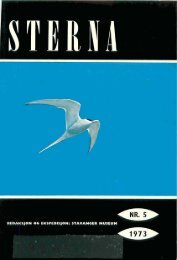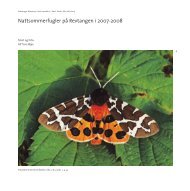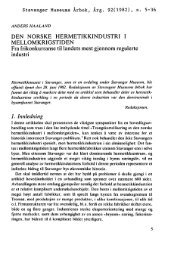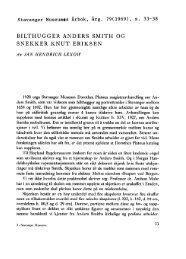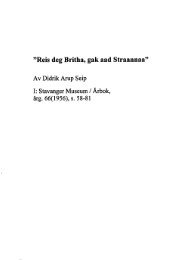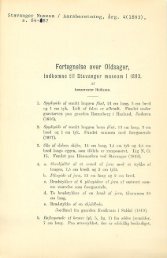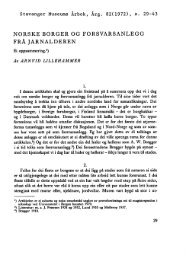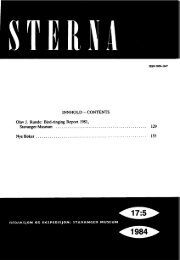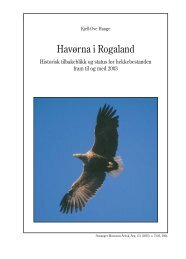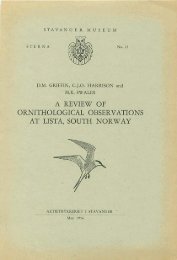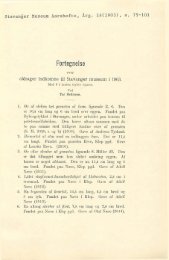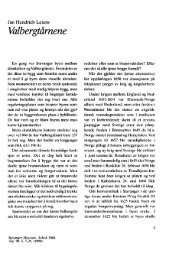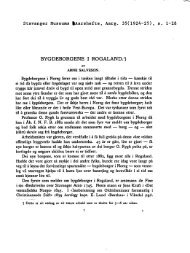The Western Conifer Seed Bug (Leptoglossus occidentalis ... - NINA
The Western Conifer Seed Bug (Leptoglossus occidentalis ... - NINA
The Western Conifer Seed Bug (Leptoglossus occidentalis ... - NINA
- No tags were found...
You also want an ePaper? Increase the reach of your titles
YUMPU automatically turns print PDFs into web optimized ePapers that Google loves.
© Norwegian Journal of Entomology. 17 June 2010<strong>The</strong> <strong>Western</strong> <strong>Conifer</strong> <strong>Seed</strong> <strong>Bug</strong> (<strong>Leptoglossus</strong> <strong>occidentalis</strong>Heidemann, 1910) (Hemiptera, Coreidae) found in SWNorwayALF TORE MJØS, TORE R. NIELSEN & FRODE ØDEGAARDMjøs, A.T., Nielsen, T.R. & Ødegaard, F. 2010. <strong>The</strong> <strong>Western</strong> <strong>Conifer</strong> <strong>Seed</strong> <strong>Bug</strong> (<strong>Leptoglossus</strong><strong>occidentalis</strong> Heidemann, 1910) (Hemiptera, Coreidae) found in SW Norway. Norw. J. Entomol. 57,20–22.<strong>Leptoglossus</strong> <strong>occidentalis</strong> Heidemann, 1910 (Hemiptera, Coreidae) was introduced to Europefrom North America, probably in 1999. Later it has spread rapidly northwards, and in October andNovember 2009 it was recorded for the first time in Norway and Denmark. L. <strong>occidentalis</strong> can be apest on about 40 conifer species.Key words: Hemiptera, Coreidae, <strong>Leptoglossus</strong> <strong>occidentalis</strong>, Norway.Alf Tore Mjøs, Stavanger Museum, Muségaten 16, NO-4010 Stavanger. E-mail:alf.tore.mjos@stavanger.museum.no.Tore Randulff Nielsen, Sandvedhagen 8, NO-4318 Sandnes. E-mail: tore@nielsen.ccFrode Ødegaard, Tungasletta 2, NO-7485 Trondheim. E-mail: frode.odegaard@nina.noIntroduction<strong>Leptoglossus</strong> <strong>occidentalis</strong> Heidemann, 1910(Hemiptera, Coreidae) is originally a Nearcticspecies, native to the western areas of NorthAmerica, from Mexico in the south throughCalifornia and Utah to British Columbia, Alberta,and Saskatchewan in the north. After World WarII the species spread eastwards: in the 1950s and1960s it reached America’s Midwest, and later ithas been found in all the eastern states (McPhersonet al. 1990, Gall 1992, Kment & Banar 2008).L. <strong>occidentalis</strong> was accidentally introduced toEurope. <strong>The</strong> insect was first discovered nearVicenza in northern Italy in autumn 1999, and soonspread to other parts of Italy (Taylor et al. 2001,Bernardinelli & Zandigiacom 2001). Recentlyit was found in additional South and CentralEuropean countries (Baranek 2007, Földessy2006, Kment & Banar 2008), and in 2008–2009an influx of L. <strong>occidentalis</strong> to the south coast ofEngland was reported on various websites.<strong>The</strong> recordsRY Klepp: Reve (EIS 7) 10 October 2009, ongrass lawn, UTM 6518523 N, 297911 E, sone 32,leg. Alf Tore Mjøs, in coll. Stavanger Museum.VAY Lindesnes: Jørgenstad near Stusvik (EIS 1)22 November 2009 indoor at window, leg. IngerM. Nielsen, in coll. T.R. Nielsen.Remarks<strong>The</strong> first records from Scandinavia are from 2009;in Denmark a specimen was found indoor atLemvig, NW Jylland on 20 October, and one wasbeaten down from Pinus on Langø, Hindsholm,Falster on 30 October (Buhl & Stephensen 2009).Also the Norwegian records are also from thatperiod (see above), which indicates a migration20
Norw. J. Entomol. 57, 20–22Figure 1. <strong>Leptoglossus</strong> <strong>occidentalis</strong> Heidemann, 1910, Revtangen Bird Observatory, Klepp, Rogaland 10October 2009. Photo: Alf Tore Mjøs, Stavanger Museum.towards Scandinavia that year.According to Veikko Rinne, Zoological Museum,University of Turku and Carl-Cedric Coulianos(both pers. comm.) the species has not yet beenfound in Finland and Sweden.Buhl & Stephensen (2009) describe the ecologyand the active global spreading of the species.IdentificationL. <strong>occidentalis</strong> Heidemann, 1910 is a large andspectacular Hemiptera in the family Coreidae,with characteristic expansions on the hind tibiaeand a white zigzag mark across the centre of theforewing. <strong>The</strong> adults are long and wide. Most oftheir body varies in colour from reddish brownto grey brown. It can hardly be mistaken for anynative European species. It is, however, similarto L. corculus (Say, 1832), but the tibia dilationextends further down on L. corculus.BiologyAdults start egg laying on the foliage ofconifers in mid to late spring. <strong>The</strong> eggs hatchafter approximately 10 days. <strong>The</strong> nymphs gothrough five stages of development before theybecome adults in late August. <strong>The</strong> bug feeds onthe developing cones and seeds of conifer trees,host plants include about 40 species, includingAbies, Cedrus, Picea, Pinus, Pseudotsugamenziesii (Mirbel) Franco, Tsuga canadensis (L.)Carrière and Calocedrus decurens (Torr.) Florin.L. <strong>occidentalis</strong> does not feed on the foliage, butpierces the cones of host plants, sucks out the seedendosperm, causing abortion and infertility of theseeds (Bates & Borden 2005). It is considereda severe pest of conifer seed orchards in North21
<strong>Leptoglossus</strong> <strong>occidentalis</strong> found in NorwayAmerica. As a result, seed losses can be as highas 50% and seedling emergence has been severelyreduced (Blatt 1996, Bates et al. 2000, 2001).As imago L. <strong>occidentalis</strong> usually spends thewinter in aggregations under peeled bark or inbird or rodent nests. In parts of the North Americathe species is a household nuisance due to its habitof entering houses for the winter. It is interesting,therefore, that the second Norwegian record wasmade indoor in late November.Acknowledgements. We would like to thank Søren Tolsgard,Naturhistorisk Museum in Århus, for information about thetwo Danish records in October 2009, Veikko Rinne, ZoologicalMuseum, University of Turku for information about the statusin Finland, and Carl-Cedric Coulianos for updated informationfrom Sweden.ReferencesBates, S.L., J.H. Borden, A. Savoie, S.E. Blatt,C.G. Lait, A.R. Kermode & R.G. Bennett. 2000.Impact of feeding by <strong>Leptoglossus</strong> <strong>occidentalis</strong>(Hemiptera: Coreidae) on the major storage reservesof mature Douglas-fir (Pinaceae) seeds. CanadianEntomologist 132, 91–102.Bates, S.L., Lait, C.G., Borden, J.H. & Kermode, A.R.2001. Effect of feeding by the western conifer seedbug, <strong>Leptoglossus</strong> <strong>occidentalis</strong>, on the major storagereserves of developing seeds and on seedling vigorof Douglas-fir. Tree Physiology 21, 481–487.Bates, S.L. & Borden, J.H. 2005. Life table for<strong>Leptoglossus</strong> <strong>occidentalis</strong> Heidemann (Heteroptera:Coreidae) and prediction of damage in lodgepolepine seed orchards. Agricultural and ForestEntomology 7(2), 145–151.Beranek, J. 2007. First Records of <strong>Leptoglossus</strong><strong>occidentalis</strong> Heidemann, 1910 (Heteroptera:Pentatomorpha: Coreidae) in the Czech Republic.Plant Protect. Sci., 43, 165–168.Bernardinelli, I. & Zandigiacom, P. (2001).<strong>Leptoglossus</strong> <strong>occidentalis</strong> Heidemann (Heteroptera,Coreidae): a <strong>Conifer</strong> seed bug recently found innorthern Italy – Presented at the 4th Workshop ofIUFRO, Praha, Czech Republic.Blatt, S.E. & Borden, J.H. 1996. Distribution andimpact of <strong>Leptoglossus</strong> <strong>occidentalis</strong> Heidemann(Hemiptera: Coreidae) in seed orchards in BritishColumbia. Canadian Entomologist 128, 1065–1076.Buhl, O. & Stephensen, B.K. 2009. Heteroptera:Coreidae. ’<strong>Western</strong> <strong>Conifer</strong> <strong>Seed</strong> <strong>Bug</strong>’, VestligNåletræs-frøtæge <strong>Leptoglossus</strong> <strong>occidentalis</strong>(Heidemann, 1910) – ny art i Danmark. –Meddelelser fra Entomologisk Selskab for Fyn 41,2009, 2, 13–16.Földessy, M. 2006. <strong>The</strong> Presence of <strong>Leptoglossus</strong><strong>occidentalis</strong> Heidemann,1910 (Heteroptera:Coreidae) in North-East Hungary. Folia HistoricoNaturalia Musei Matraensis 30, 203–204.Gall, W.K. 1992. Further eastern range extensionand host records for <strong>Leptoglossus</strong> <strong>occidentalis</strong>(Heteroptera: Coreidae): well-documented dispersalof a household nuisance. Great Lakes Entomologist25, 159–171.Kment, P. & Banar, P. 2008. Invasive Nearctic bug<strong>Leptoglossus</strong> <strong>occidentalis</strong> in Croatia. Nat. Croat.Vol. 17(2), 141–147.McPherson, J. E., R. J. Packauskas, S. J. Taylor, &M. F. O‘Brien. 1990. Eastern range extension of<strong>Leptoglossus</strong> <strong>occidentalis</strong> with a key to <strong>Leptoglossus</strong>species of America north of Mexico (Heteroptera:Coreidae). <strong>The</strong> Great Lakes Entomologist 23(2),99–104.Taylor, S. J., Tescari, G. & Villa, M. 2001. A Nearcticpest of Pinaceae accidentally introduced intoEurope: <strong>Leptoglossus</strong> <strong>occidentalis</strong> (Heteroptera:Coreidae) in northern Italy. Entomological News112(2), 101–103.Received: 9 February 2010Accepted: 12 May 201022



